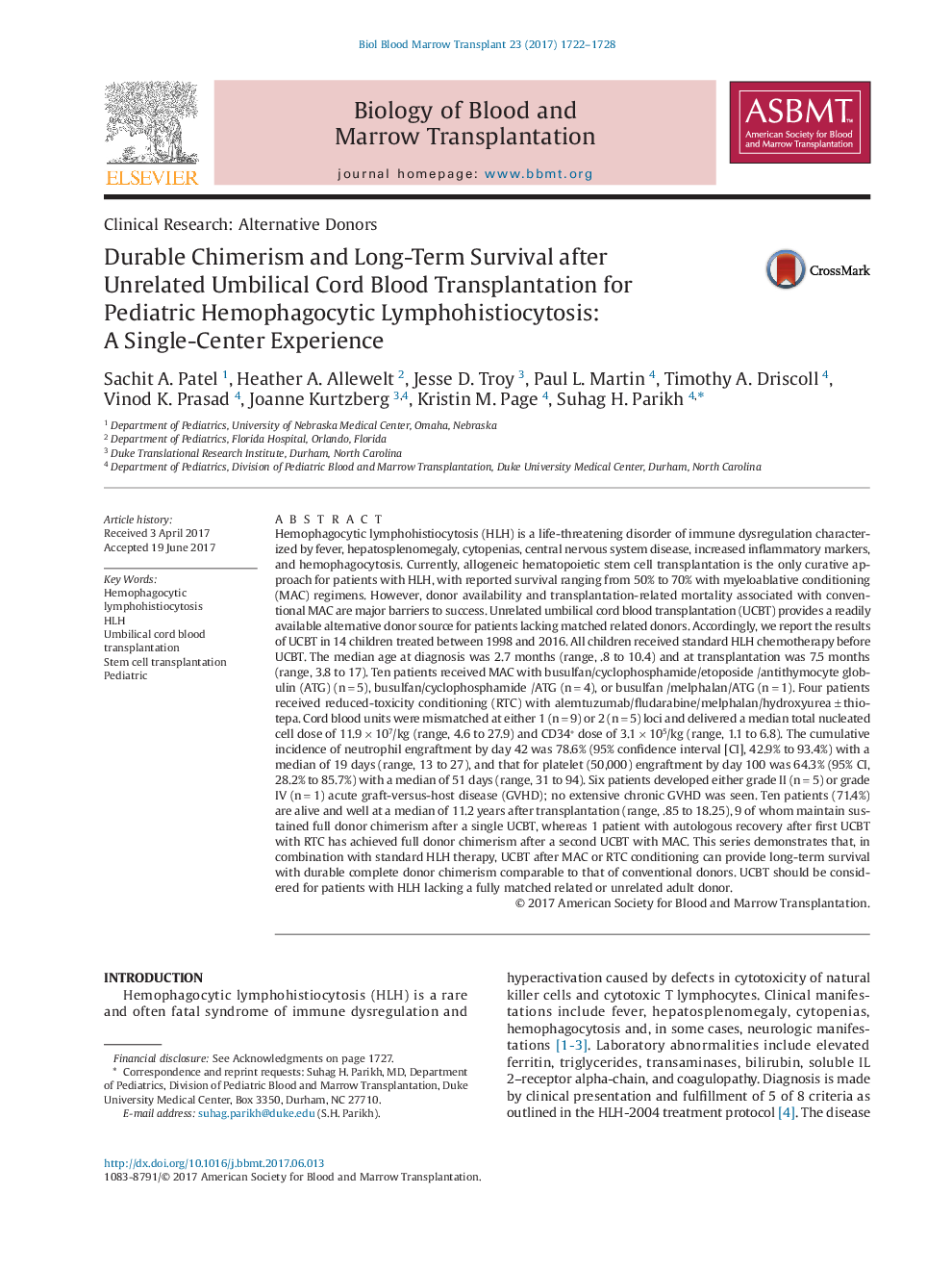| Article ID | Journal | Published Year | Pages | File Type |
|---|---|---|---|---|
| 5524058 | Biology of Blood and Marrow Transplantation | 2017 | 7 Pages |
â¢Umbilical cord blood transplantation can provide durable engraftment in pediatric patients with hemophagocytic lymphohistiocytosisâ¢Umbilical cord blood transplantation may lead to long-term disease free survival in pediatric patients with hemophagocytic lymphohistiocytosisâ¢Reduced-toxicity conditioning is feasible with umbilical cord blood transplantation in pediatric patients with hemophagocytic lymphohistiocytosisâ¢Umbilical cord blood transplantation deserves further study in a larger prospective trial of pediatric patients with hemophagocytic lymphohistiocytosis
Hemophagocytic lymphohistiocytosis (HLH) is a life-threatening disorder of immune dysregulation characterized by fever, hepatosplenomegaly, cytopenias, central nervous system disease, increased inflammatory markers, and hemophagocytosis. Currently, allogeneic hematopoietic stem cell transplantation is the only curative approach for patients with HLH, with reported survival ranging from 50% to 70% with myeloablative conditioning (MAC) regimens. However, donor availability and transplantation-related mortality associated with conventional MAC are major barriers to success. Unrelated umbilical cord blood transplantation (UCBT) provides a readily available alternative donor source for patients lacking matched related donors. Accordingly, we report the results of UCBT in 14 children treated between 1998 and 2016. All children received standard HLH chemotherapy before UCBT. The median age at diagnosis was 2.7 months (range, .8 to 10.4) and at transplantation was 7.5 months (range, 3.8 to 17). Ten patients received MAC with busulfan/cyclophosphamide/etoposide /antithymocyte globulin (ATG) (nâ=â5), busulfan/cyclophosphamide /ATG (nâ=â4), or busulfan /melphalan/ATG (nâ=â1). Four patients received reduced-toxicity conditioning (RTC) with alemtuzumab/fludarabine/melphalan/hydroxyureaâ±âthiotepa. Cord blood units were mismatched at either 1 (nâ=â9) or 2 (nâ=â5) loci and delivered a median total nucleated cell dose of 11.9 à 107/kg (range, 4.6 to 27.9) and CD34+ dose of 3.1 à 105/kg (range, 1.1 to 6.8). The cumulative incidence of neutrophil engraftment by day 42 was 78.6% (95% confidence interval [CI], 42.9% to 93.4%) with a median of 19 days (range, 13 to 27), and that for platelet (50,000) engraftment by day 100 was 64.3% (95% CI, 28.2% to 85.7%) with a median of 51 days (range, 31 to 94). Six patients developed either grade II (nâ=â5) or grade IV (nâ=â1) acute graft-versus-host disease (GVHD); no extensive chronic GVHD was seen. Ten patients (71.4%) are alive and well at a median of 11.2 years after transplantation (range, .85 to 18.25), 9 of whom maintain sustained full donor chimerism after a single UCBT, whereas 1 patient with autologous recovery after first UCBT with RTC has achieved full donor chimerism after a second UCBT with MAC. This series demonstrates that, in combination with standard HLH therapy, UCBT after MAC or RTC conditioning can provide long-term survival with durable complete donor chimerism comparable to that of conventional donors. UCBT should be considered for patients with HLH lacking a fully matched related or unrelated adult donor.
